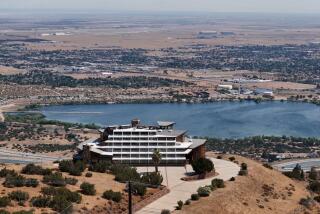IBM Gets in on Ground Floor of State’s ‘Smart’ Home Market
- Share via
At Rolling Hills Estates, an upscale residential complex under construction in Poway in San Diego County, the houses are large and luxurious--and “smart.” IBM Corp. hopes they will be the first wave of high-tech homes in California to adopt its Home Director service.
As part of an aggressive push behind the computer company’s home network solution, IBM is working with several California real estate developers to install and promote its high-speed home networking system. Part automation system, part computer network, Home Director promises to turn any residence into the fantasy Jetson home.
The system, which runs on Windows 95 and relies on a TV interface, sends and receives data through a computer server tucked in a closet. By routing information to different modules and motion sensors scattered throughout the house, a variety of appliances can be adjusted or connected to one another.
With a single TV remote, air conditioners can be set and a VCR in the living room can play a video, while a DVD player is switched on in the bedrooms. While channel-surfing from the couch, users can turn to the program’s graphical main menu. From there, they can boot up the PC in the den, switch on the nannycam in the kids’ room, or flip the lights off at bedtime. And for the Internet-happy family, up to eight PCs can be online--and networked together--at once.
“This is all about building a home’s digital plumbing and making sure it works with all sorts of technologies, new and old,” said Mark Schmidt, director of brand marketing for IBM’s home networking division. “We think the demand is there, particularly in Southern California.”
The convenience comes with a price. Buyers pay $3,000 for the digital wiring installed in new construction and another $7,000 to $10,000 for the applications and appliances. For an existing home, installers would tack on another 30%, IBM officials said.
“These kinds of systems are spendy and complex,” said Kevin Hause, an industry analyst with International Data Corp. “I can see the appeal for new developments, but not for retrofitting a home that’s already built. How many people are going to pay several thousand dollars to retrofit their house just so they can change the thermostat from their couch?”
Though the demand for high-speed connectivity and gee-whiz features may be high, the adoption rate for such automated systems has remained low because of the expense. But as the cost of the technology drops, analysts at Forrester Research predict, the market for home network equipment will reach $2 billion by 2002.
This trend could be pushed forward in California by the current boom of home construction, which can’t keep up with demand, say real estate analysts. Even though California’s hot housing market is expected to cool slightly next year, projected sales will still make 1999 the fourth-best year on record, according to the California Assn. of Realtors.
Hoping to quicken the adoption rate of home networking technology, several industry consortiums--some of which IBM has joined--are trying to find ways around today’s price barrier. The Home Phoneline Networking Alliance has promised to unveil a high-speed home-networking standard this year that runs over ordinary phone lines and doesn’t interfere with existing services. And the Home Radio Frequency Working Group is developing a wireless networking standard that will let multiple PCs, phones and other devices connect to one another.
So far, however, the cost hasn’t hampered the technology’s appeal in San Diego County. Of the 75 homes built in the Poway complex so far, 50% of the property owners have installed the digital infrastructure needed to run the IBM service, according to project developers Shea Homes.
The service is being distributed in Southern California by Advanced Protection Systems Inc. in El Cajon. Northern California is covered by Digital Interiors Inc., a San Jose-based residential systems integrator. IBM also is working with Land Tejas Development of Houston, which is wiring at least 4,000 new homes with high-speed cabling and offering Home Director as an add-on.
But networking experts insist IBM’s solution will remain a novelty item, at least while the price is so high.
“Even if IBM got its solution into all new homes being built--which I think is unlikely--that’s still a very low penetration rate,” said Bruce Kasrel, a senior industry analyst for Forrester Research. “If companies keep pricing home networks in this range, then the home of the future will remain there.”
*
Times staff writer P.J. Huffstutter can be reached via e-mail at p.j.huffstutter@latimes.com.
More to Read
Inside the business of entertainment
The Wide Shot brings you news, analysis and insights on everything from streaming wars to production — and what it all means for the future.
You may occasionally receive promotional content from the Los Angeles Times.










